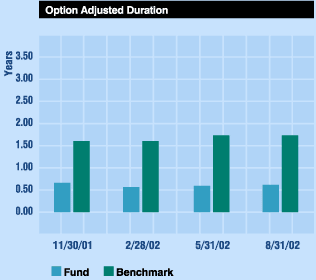Short Intermediate Term Fund ($1,435.9 million)
Overview
The Short Intermediate Term Fund (SITF) commenced operations on March 1, 1993. The SITF is an internal UT System mutual fund for the pooled investment of UT System institutional operating funds with an investment horizon greater than one year. The SITF also serves as the source of a $350 million self-liquidity facility for the Board of Regents of The University of Texas System Revenue Financing System Notes program. During the year ended August 31, 2001, the SITF entered into an additional commitment in connection with the Board of Regents of The University of Texas System Revenue Financing System Bonds, Series 2001A. As of August 31, 2002, the SITF is committed to a maximum purchase commitment of $71.4 million in the event of a failed remarketing of the Series 2001A bonds.
The SITF is structured as a mutual fund in which institutions can purchase or sell units at market value weekly on Wednesdays and the first business day of each month. The SITF's income is either reinvested or distributed to the institutions monthly at their election. Distributions from the SITF are used by UT System institutions for intermediate term cash management associated with capital projects and other general institutional purposes.
The SITF's primary investment objective is to provide both (1) income and (2) capital appreciation when consistent with income generation, reasonable preservation of capital and the maintenance of adequate SITF liquidity.
The SITF emphasizes moderate liquidity and safety of principal through investment in high grade fixed income and floating rate obligations. The SITF's investments are diversified among eligible asset classes and issuers (excluding the U.S. Government) as defined in the SITF's investment policy. The SITF carries an AAAf credit rating and a bond volatility risk rating of S2 from Standard & Poor's Inc. AAA is the highest quality rating issued by S&P. An S2 rating indicates low to moderate market risk exposure.
Financial Highlights
The SITF's net assets were $1,435.9 million at August 31, 2002. The chart below summarizes the components of the SITF's net assets for the past five years.

Click to print charts in this section using PDF format
Investment Return
The SITF's net return for the year was 3.75% (net of investment management fees). The chart below compares the SITF's performance against its policy portfolio benchmark. The policy portfolio benchmark is a composite index consisting of Government Federal Agencies, Government Treasuries and Treasury bills.

Click to print charts in this section using PDF format
The SITF investment policy mitigates interest rate risk by limiting the portfolio's duration to a range of 0.5 years to 4 years. Duration estimates the impact small changes in interest rates will have on the value of the portfolio. At August 31, 2002, the option adjusted duration of the portfolio was .56 years compared to 1.69 years for its policy portfolio. Simplistically, if there is a 1.00% increase (decrease) in yields, the value of the portfolio would (decrease) increase by .56%. The exposure of the SITF to interest rate increases has been minimized to protect the fund from expected interest rate increases as the U.S. economy recovers. The extensive monetary and fiscal stimulus applied by authorities over the past 24 months will ultimately power the sluggish economy. When that occurs, the SITF can take advantage of higher rates without suffering significant capital losses in the interim.

Click to print charts in this section using PDF format

